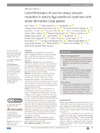Identificador persistente para citar o vincular este elemento:
https://accedacris.ulpgc.es/jspui/handle/10553/106028
| Título: | Cost-effectiveness of positive airway pressure modalities in obesity hypoventilation syndrome with severe obstructive sleep apnoea | Autores/as: | Masa, Juan F Mokhlesi, Babak Benítez, Iván Gómez de Terreros Caro, Francisco Javier Sánchez-Quiroga, M-Ángeles Romero, Auxiliadora Caballero, Candela Alonso-Álvarez, Maria Luz Ordax-Carbajo, Estrella Gómez-García, Teresa González, Mónica López-Martín, Soledad Marin, Jose M Martí, Sergi Díaz-Cambriles, Trinidad Chiner, Eusebi Egea, Carlos Barca, Javier Vázquez Polo, Francisco José Negrín Hernández, Miguel Ángel Martel Escobar, María Carmen Barbé, Ferran Corral-Peñafiel, Jaime |
Clasificación UNESCO: | 530202 Modelos econométricos 531207 Sanidad |
Palabras clave: | Enfermedades respiratorias Análisis coste beneficio Estadística bayesiana |
Fecha de publicación: | 2020 | Proyectos: | PI050402, Spanish Respiratory Foundation 2005 (FEPAR) and Air Liquide Spain | Publicación seriada: | Thorax | Resumen: | Background Obesity hypoventilation syndrome (OHS) is treated with either non-invasive ventilation (NIV) or CPAP, but there are no long-term cost-effectiveness studies comparing the two treatment modalities. Objectives We performed a large, multicentre, randomised, open-label controlled study to determine the comparative long-term cost and effectiveness of NIV versus CPAP in patients with OHS with severe obstructive sleep apnoea (OSA) using hospitalisation days as the primary outcome measure. Methods Hospital resource utilisation and within trial costs were evaluated against the difference in effectiveness based on the primary outcome (hospitalisation days/year, transformed and non-transformed in monetary term). Costs and effectiveness were estimated from a log-normal distribution using a Bayesian approach. A secondary analysis by adherence subgroups was performed. Results In total, 363 patients were selected, 215 were randomised and 202 were available for the analysis. The median (IQR) follow-up was 3.01 (2.91-3.14) years for NIV group and 3.00 (2.92-3.17) years for CPAP. The mean (SD) Bayesian estimated hospital days was 2.13 (0.73) for CPAP and 1.89 (0.78) for NIV. The mean (SD) Bayesian estimated cost per patient/year in the NIV arm, excluding hospitalisation costs, was €2075.98 (91.6), which was higher than the cost in the CPAP arm of €1219.06 (52.3); mean difference €857.6 (105.5). CPAP was more cost-effective than NIV (99.5% probability) because longer hospital stay in the CPAP arm was compensated for by its lower costs. Similar findings were observed in the high and low adherence subgroups. Conclusion CPAP is more cost-effective than NIV; therefore, CPAP should be the preferred treatment for patients with OHS with severe OSA. Trial registration number NCT01405976 © Author(s) (or their employer(s)) 2020. No commercial re-use. See rights and permissions | URI: | https://accedacris.ulpgc.es/handle/10553/106028 | ISSN: | 0040-6376 | DOI: | 10.1136/thoraxjnl-2019-213622 | Fuente: | Thorax [0040-6376], v. 75(6), p. 439-440 |
| Colección: | Artículos |
Citas de WEB OF SCIENCETM
Citations
16
actualizado el 08-jun-2025
Visitas
177
actualizado el 11-ene-2025
Descargas
495
actualizado el 11-ene-2025
Google ScholarTM
Verifica
Altmetric
Comparte
Exporta metadatos
Los elementos en ULPGC accedaCRIS están protegidos por derechos de autor con todos los derechos reservados, a menos que se indique lo contrario.
